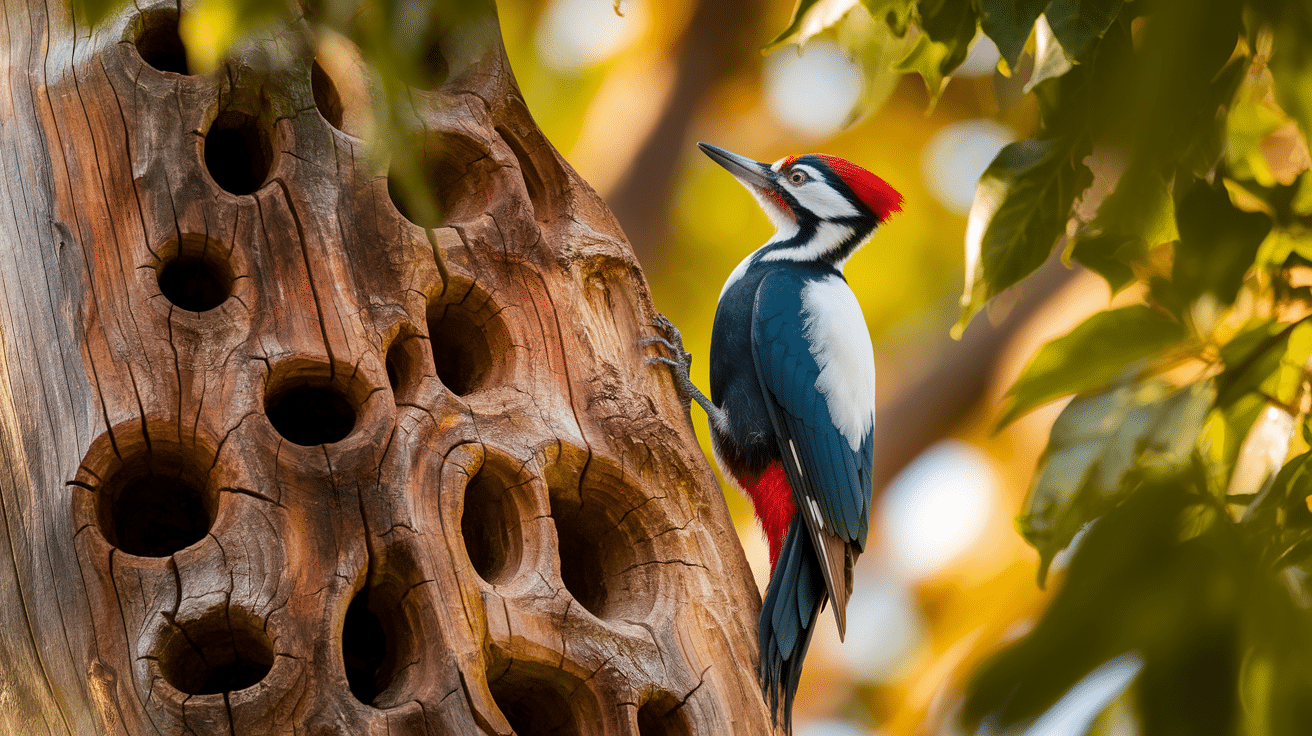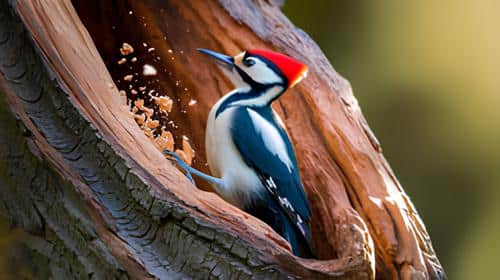Have you ever noticed large, rectangular holes in tree trunks while walking through the woods?
These holes are made by pileated woodpeckers, a striking bird with a bright red head.
But why do they make these holes?
Pileated woodpeckers peck at trees to find food, build nests, and create homes for other animals. They are nature’s carpenters, helping to keep the forest healthy by targeting trees that are full of insects or decaying.
In this guide, you will learn how to identify these unique holes and what purpose they serve in the forest.
How to Identify Pileated Woodpecker Holes?
First, look for the shape. Pileated Woodpecker holes are uniquely rectangular, unlike the round holes created by most other woodpeckers.
They are also impressively large, often 3-8inches long and 3-5 inches wide, about the size of a crow-sized bird.
Fresh wood will have clean edges with a light-colored surface, whereas older wood will darken with time.
Why Do They Create These Holes?
- To extract other wood-boring insects and larvae from tree trunks
- Create nesting cavities for raising their young each spring
- Make roosting holes for sleeping safely at night
- Establish and defend their territory against other woodpeckers
Common Trees Used by Pileated Woodpeckers
| Tree Type | Characteristics |
|---|---|
| Dead or Dying Trees | Softwood for pecking, often filled with carpenter ant colonies. |
| Eastern White Pine | Frequently chosen, especially older specimens. |
| Maples | Common targets due to their size and potential insect presence. |
| Oaks | Large, mature oaks are often selected, particularly when showing signs of insect activity. |
| Hemlocks | Often chosen when infested with insects. |
| Aspens and Poplars | Softer wood that makes pecking easier. |
| Beech Trees | Targeted if diseased, decayed, or harboring carpenter ant galleries. |
Importance of Pileated Woodpecker Holes
Below is the list of the major importance of pileated woodpecker holes:
-
Shelter for Other Species: Once abandoned, the woodpecker’s large cavities become homes for a variety of birds, mammals, and insects.
-
Promote Forest Health: By targeting diseased or insect-infested trees, these birds help manage pests and prevent further decay.
-
Natural Recycling: As the woodpeckers carve into aging trees, they aid in breaking down dead wood and promoting new growth.
-
Support Tree Regeneration: Removing compromised wood creates space for new, healthy growth in the forest ecosystem.
-
Indicator of Ecosystem Health: The presence of pileated woodpeckers and their holes signals a balanced environment and biodiversity.
-
Upgrade Wildlife Viewing: For birdwatchers, these holes provide an opportunity to observe the behavior of woodpeckers.
-
Educational and Scientific Value: Studying these holes provides insights into forest dynamics, species interactions, and the benefits of natural forest decay.
How to Observe Pileated Woodpeckers?

To observe pileated woodpeckers, wake up early in the morning and find a quiet, wooded area.
These birds are often heard before they are seen, so listen carefully for their loud, laughing calls and the drumming sounds they make.
Once you hear them, look for their signature rectangular holes in dead or decaying trees, as well as fresh wood shavings on the ground, which can identify their presence.
- Use Binoculars: Binoculars will help you spot them more easily.
- Bring a Field Guide: To identify the pileated woodpecker’s unique features.
- Stay Alert and Watch the Treetops: They tend to be on top, so search the treetops.
- Watch for Feeding Behavior: They may be pecking at the bark or pulling insects from holes.
Conclusion
No doubt, the pileated woodpecker plays an important role in the forest. They create holes in trees to find food, build nests, and help other animals.
However, these holes also help keep the forest healthy by removing old or damaged trees.
Next time you are in the woods, keep an eye out for these unique holes because they are signs of a woodpecker’s hard work!















